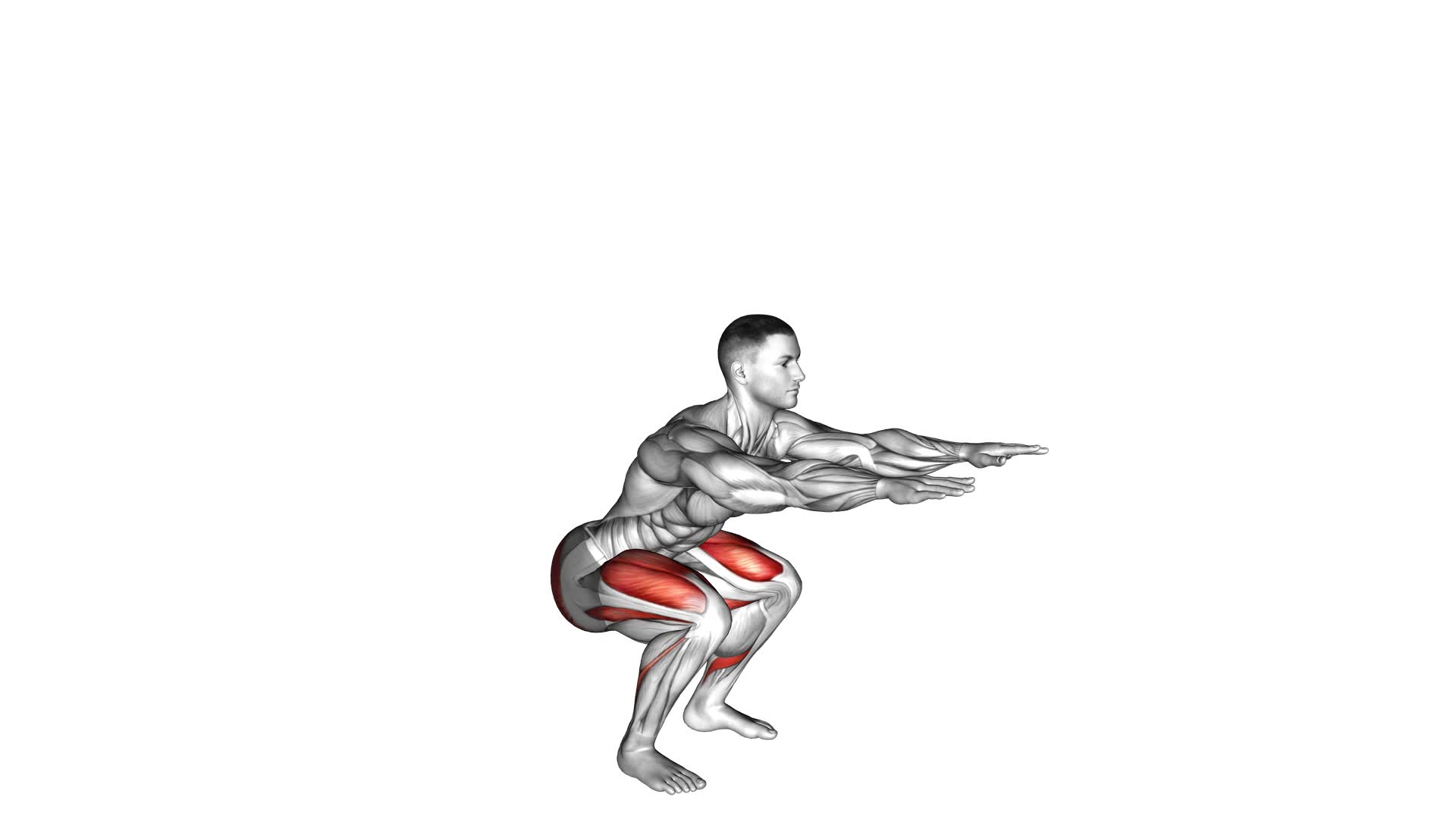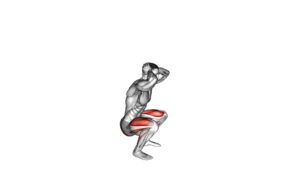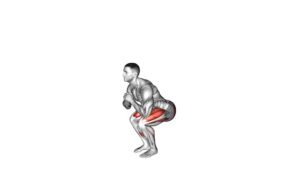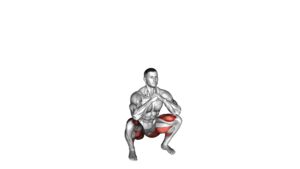Bodyweight Squat (male) – Video Exercise Guide & Tips

Looking to build strength and tone your lower body? Then you're in the right place! In this video exercise guide, we'll show you the proper form and technique for the bodyweight squat.
Watch This Exercise Video
Whether you're a beginner or more advanced, we've got you covered with progressions and variations to challenge you.
Plus, we'll share some tips to help you get the most out of your workout.
So grab a mat and let's get started!
Key Takeaways
- Bodyweight squats strengthen lower body muscles such as quadriceps, hamstrings, and glutes.
- Proper form and technique include maintaining hip and knee alignment, engaging the core for stability, sitting back into an imaginary chair, and keeping the chest lifted throughout the movement.
- Common mistakes to avoid in bodyweight squats include knees caving in, lack of depth, rounding the back, and lifting heels off the ground.
- Progressions and variations of bodyweight squats include pistol squats, jump squats, Bulgarian split squats, and overhead squats.
Benefits of Bodyweight Squats
What are the benefits of doing bodyweight squats?
Bodyweight squats are a simple yet highly effective exercise that can provide numerous benefits for your body. First and foremost, they help to strengthen your lower body muscles, including your quadriceps, hamstrings, and glutes. By engaging these muscles, bodyweight squats can improve your overall lower body strength and power.
In addition to building strength, bodyweight squats also help to improve your balance and stability. These exercises require you to maintain proper form and control throughout the movement, which can enhance your proprioception and coordination.
Another benefit of bodyweight squats is that they can be done anywhere, without the need for any equipment. This makes them a convenient exercise option, especially for those who don't have access to a gym or prefer to work out at home.
To maximize the benefits of bodyweight squats and maintain proper form, there are a few tips to keep in mind. First, make sure to keep your feet shoulder-width apart and your toes pointing slightly outward. As you lower into the squat, focus on keeping your knees aligned with your toes and your chest up. Additionally, engage your core throughout the movement to stabilize your spine.
Proper Bodyweight Squat Form
When performing a bodyweight squat, it's crucial to maintain proper hip and knee alignment. This means keeping your knees in line with your toes and your hips back and down.
Additionally, focus on engaging your core for stability and balance throughout the movement.
Hip and Knee Alignment
To achieve proper hip and knee alignment during a bodyweight squat, focus on maintaining a straight back and keeping your knees in line with your toes. Proper squat technique is essential for preventing injuries and maximizing the effectiveness of the exercise.
When performing a bodyweight squat, start by standing with your feet shoulder-width apart and your toes slightly turned out. As you lower your body into the squat, imagine sitting back into an imaginary chair, keeping your weight on your heels. Make sure to engage your core muscles and keep your chest lifted throughout the movement.
As you descend, your knees should track over your toes, ensuring proper alignment and reducing the risk of knee strain. By maintaining proper hip and knee alignment, you can perform bodyweight squats with confidence and reap the full benefits of this exercise.
Core Stability and Balance
To achieve optimal core stability and balance during a bodyweight squat, focus on engaging your abdominal muscles and maintaining a steady center of gravity throughout the movement. Core activation is essential for maintaining proper form and preventing injury. By engaging your abs, you create a solid foundation that allows for better balance and control.
Imagine pulling your belly button in towards your spine as you lower down into the squat and push through your heels to rise back up. This muscle engagement not only supports your spine but also helps to stabilize your entire body. Keeping a steady center of gravity ensures that you maintain control and avoid leaning too far forward or backward.
With proper core stability and balance, you can perform bodyweight squats effectively and safely.
Now, let's move on to the next section and discuss common mistakes to avoid in order to further enhance your squatting technique.
Common Mistakes to Avoid
Are you unknowingly making mistakes while performing the bodyweight squat exercise? Proper form is crucial to maximize the benefits of this exercise and prevent injuries. Here are some common mistakes to avoid:
- Knees caving in: Keep your knees in line with your toes throughout the movement. Avoid letting them collapse inward, as this puts unnecessary stress on your knee joints.
- Lack of depth: Going too shallow in your squat limits the activation of your glutes and hamstrings. Aim to lower your hips below parallel, while maintaining proper form.
- Rounding the back: Keep your spine straight and avoid rounding your back during the squat. Engage your core muscles to maintain a stable and neutral spine position.
- Lifting heels off the ground: Your heels should remain grounded throughout the movement. If you struggle with this, try elevating your heels slightly by placing a small weight plate or wedge under them.
By avoiding these common mistakes, you can ensure that you're performing bodyweight squats correctly and effectively.
Now, let's move on to the next section and explore progressions and variations of this exercise.
Progressions and Variations
Now let's explore some advanced squat variations to take your workout to the next level.
These variations can challenge your muscles in new ways and help you progress towards more difficult exercises.
Additionally, if you're just starting out or looking for a modification, we'll discuss scaling options for beginners to ensure proper form and gradual progression.
Advanced Squat Variations
Try incorporating advanced squat variations into your workout routine to challenge your muscles and take your squats to the next level. Here are some advanced squat techniques that will help you increase the intensity of your squats:
- Pistol Squats: Perform squats on one leg, keeping the other leg extended in front of you.
- Jump Squats: Add explosive power to your squats by jumping up from the squat position.
- Bulgarian Split Squats: Elevate one foot behind you on a bench or step while performing squats with the other leg.
- Overhead Squats: Hold a weight above your head while squatting to engage your core and upper body.
By incorporating these advanced squat variations into your routine, you'll challenge your muscles in new ways and see greater gains in strength and stability.
Now, let's discuss how to scale these exercises for beginners.
Scaling for Beginners
To scale these advanced squat variations for beginners, you can start with simpler progressions and variations that will help you build strength and confidence in your squatting technique.
One beginner modification is the box squat. This involves squatting down onto a box or bench, which helps to limit the range of motion and makes it easier to maintain proper form.
Another modification is the assisted squat, where you hold onto a stable object like a TRX strap or a door frame for support. This allows you to focus on your technique without worrying about balance.
Common challenges for beginners include maintaining proper form, keeping the heels on the ground, and building enough strength in the lower body.
Tips for Maximizing Results
To maximize your results, focus on maintaining proper form and engaging your core throughout the bodyweight squat exercise. Here are some tips to help you get the most out of your workouts:
- Vary the intensity: To maximize gains, it's important to challenge your muscles. Try incorporating different variations of the bodyweight squat, such as jump squats or pistol squats, to keep your muscles guessing and promote growth.
- Increase training frequency: Consistency is key when it comes to seeing results. Aim to perform bodyweight squats at least two to three times a week to build strength and endurance. Gradually increase the number of sets and reps as you progress.
- Use proper technique: Pay attention to your form to ensure you're targeting the correct muscles and avoiding injury. Keep your chest up, back straight, and knees aligned with your toes. Engage your core throughout the movement for added stability and strength.
- Incorporate resistance: Once bodyweight squats become easy, consider adding resistance to further challenge your muscles. You can use dumbbells, kettlebells, or resistance bands to make the exercise more challenging and maximize your gains.
Safety Precautions and Considerations
Ensure proper form and minimize the risk of injury by practicing the bodyweight squat with caution and adhering to safety precautions. Injury prevention should be a top priority in any exercise routine, and the bodyweight squat is no exception. To protect yourself from potential harm, it's crucial to follow these safety guidelines.
Firstly, wearing the proper footwear is essential. Choose sneakers or athletic shoes that provide adequate support and cushioning for your feet. This will help absorb impact and reduce the risk of strains or sprains. Avoid exercising in flip-flops, sandals, or any shoes with an unstable sole.
Additionally, warm up before performing bodyweight squats. Engage in dynamic stretches or light cardio exercises to increase blood flow to your muscles and prepare them for the workout. This will help prevent muscle strains or tears.
Maintain proper form throughout the exercise to avoid unnecessary stress on your joints. Keep your feet shoulder-width apart, chest up, and back straight. Bend your knees and lower your hips until your thighs are parallel to the ground. Push through your heels to return to the starting position.
Incorporating these safety precautions into your bodyweight squat routine will help you minimize the risk of injury and achieve optimal results. Remember to listen to your body, start with proper form, and gradually increase the intensity and repetitions over time.
Stay safe and enjoy the benefits of this effective exercise.
Frequently Asked Questions
How Many Bodyweight Squats Should I Do in a Single Workout Session?
To determine how many bodyweight squats you should do in a single workout session, it's important to consider your fitness level and goals. Bodyweight squats are a great exercise for building strength and endurance.
Adding weight to your bodyweight squats can provide additional benefits, such as increased muscle activation and improved overall strength.
There are also variations of bodyweight squats that cater to different fitness levels, allowing you to progress and challenge yourself as you become stronger.
Can Bodyweight Squats Help Me Build Muscle?
Bodyweight squats are a great exercise for building muscle. They target your legs, glutes, and core, helping you develop strength and power.
By incorporating different variations of bodyweight squats into your workout routine, such as jump squats or pistol squats, you can challenge your muscles even more.
The benefits of bodyweight squats for strength training are numerous, including improved balance, increased muscle endurance, and enhanced overall athletic performance.
Are Bodyweight Squats Suitable for Beginners?
Yes, bodyweight squats are suitable for beginners. They're a great exercise to build strength and improve overall fitness.
When performing bodyweight squats, it's important to maintain proper form. Keep your feet shoulder-width apart, bend your knees, and lower your hips towards the ground. Make sure to keep your chest up and your back straight.
If you're a beginner, you can modify the exercise by using a chair for support or by performing partial squats until you build enough strength.
Should I Perform Bodyweight Squats Before or After My Cardio Workout?
When it comes to the timing of your bodyweight squats, it's important to consider a few things. Ideally, you should perform them before your cardio workout. This way, your muscles are warmed up and ready to go.
However, if you prefer to do your cardio first, that's okay too. Just make sure to focus on proper form during your squats to avoid injury.
Can Bodyweight Squats Help Improve My Athletic Performance in Other Sports?
Bodyweight squats can definitely improve your athletic performance in other sports. They may not be as effective as weighted squats for building pure strength, but they offer unique benefits.
Bodyweight squats help develop stability, mobility, and functional movement patterns that are essential in sports.
Plus, they can be modified to mimic specific movements in your sport, making them even more effective.
Conclusion
Incorporating bodyweight squats into your exercise routine can provide numerous benefits, such as strengthening your lower body muscles and improving overall stability. By maintaining proper form and avoiding common mistakes, you can maximize the effectiveness of this exercise.
Additionally, exploring progressions and variations can help challenge your muscles and keep your workouts interesting. Remember to prioritize safety by listening to your body and making necessary adjustments.
Start incorporating bodyweight squats into your workouts and enjoy the results!

Author
Years ago, the spark of my life’s passion ignited in my mind the moment I stepped into the local gym for the first time. The inaugural bead of perspiration, the initial endeavor, the very first surge of endorphins, and a sense of pride that washed over me post-workout marked the beginning of my deep-seated interest in strength sports, fitness, and sports nutrition. This very curiosity blossomed rapidly into a profound fascination, propelling me to earn a Master’s degree in Physical Education from the Academy of Physical Education in Krakow, followed by a Sports Manager diploma from the Jagiellonian University. My journey of growth led me to gain more specialized qualifications, such as being a certified personal trainer with a focus on sports dietetics, a lifeguard, and an instructor for wellness and corrective gymnastics. Theoretical knowledge paired seamlessly with practical experience, reinforcing my belief that the transformation of individuals under my guidance was also a reflection of my personal growth. This belief holds true even today. Each day, I strive to push the boundaries and explore new realms. These realms gently elevate me to greater heights. The unique combination of passion for my field and the continuous quest for growth fuels my drive to break new ground.



